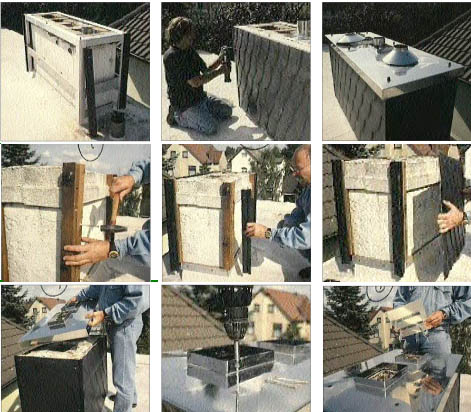 Chimneys have to withstand harsh climates for many years. With a second skin you can protect them well from external damage.
Chimneys have to withstand harsh climates for many years. With a second skin you can protect them well from external damage.
Just like the facade or the roof of the house, the chimney cap is one of the components most affected by the climate. He must rain and storm, Resist heat and frost, and that for many decades. The surfaces of the chimney caps must therefore be made of frost-resistant building materials and protected against the ingress of rainwater. Has the ravages of time left its mark here and are showing cracks and washed-out joints, must be acted upon immediately, to avoid serious consequential damage.
Regional differences
In Germany, chimney heads are mostly adapted to the prevailing regional building styles. In northern Germany, for example, brick heads made of hard-burned clinker are very common. In the Swabian area, in the Allgäu and in parts of Bavaria you can often see the plastered chimney cap, and everywhere, where slate roofs are more common (z.B. in parts of Hesse), the chimney cap is also protected against wind and weather with slabs of slate. Even with such different designs, chimney hoods can be installed. If the building is in poor condition, cleaning work should be carried out on the chimney (the DIN applies to this 18 550) and masonry work should always be left to the specialist.
Is the basic substance not yet attacked?, you can achieve safe and lasting protection with chimney cap coverings. Four types of design have proven themselves as sheathing or cladding: Finishing head: A cover shell, prefabricated exactly to measure, is slipped over the existing chimney cap and fixed to it. They are available as solid concrete heads with a wall thickness of 6 to 10 centimeters and as a prefabricated aluminum frame, paneled with fiber cement panels and closed from above with a stainless steel cover. This system is also easy to install by Seibermacher.
The aluminum frame of the finished chimney head is fixed to the old chimney head with adjusting screws. Plastic corner profiles cover the edges of the cover plates.
The cover plates made of fiber cement have a slate structure and are supplied cut to size with the finished cap head. They are bolted to the aluminum frame.
Mounted very quickly: A prefabricated stainless steel cover hood is screwed onto the construction and a conical rain collar is placed on the flue pipe.
Always with rear ventilation
There should always be an air gap of 3 to 6 centimeters remain, and the fairing should be open at the bottom. This ensures good rear ventilation at all times. This is to ensure, that the condensate that otherwise occurs due to the high vapor diffusion resistance of the cladding does not cause any corrosion or sooting on the chimney.
Cladding with panels
Anyone who is handy, can also make a slip-on head fairing yourself. Three materials are suitable for this: fiber cement panels: In terms of the basic structure, this method corresponds to the renovation with ready-made slip heads. Here, however, the individual components are cut to size on site and assembled piece by piece.
Instead of the finished aluminum frame, a vertical construction made of battens is screwed to the chimney cap. The timbers are firmly anchored at the head with dowels and then have to be covered with mineral building materials so that they are flush with the surface. is called area density, that each side of the chimney must consist of a completely closed panel, so that no driving rain can penetrate. Here, too, panels made of fiber cement have proven their worth. They are easy to cut with a jigsaw, correspond to the relevant fire protection regulations and are available in different colors and surfaces (with. B. in slate decor) available. A made-to-measure cover hood made of stainless steel is then screwed onto the chimney mouth from above, as with the pre-fab head. Special cover plates made of fiber cement or rain collars made of stainless steel seal the edge of the flue pipe connection against moisture.
stainless steel- or copper plates: Stainless steel plates or copper sheets can also be used for the cladding. They are nailed or screwed onto the batten substructure previously installed. Sufficient rear ventilation must also be ensured here. However, both metal materials are more difficult to cut and process than e.g. Fiber cement panels, and they are also considerably more expensive. In addition, at least stainless steel requires special cutting tools for processing.
Better with the professional – Numerous structural regulations must also be observed when installing the slip-on head, which also differ in some federal states. Therefore, always coordinate your measures with your district master chimney sweep before construction begins.
The vertical construction made of roof battens is fastened with push-through dowels when building the cladding yourself. The plastic corner profiles are attached to the substructure with screws. They cover the plate edges. The fiber cement cover panels are cut to size on site, in die Eckprofile geschoben und verschraubt. Die Abdeckhaube aus Edelstahl wird im Werk für jedes Objekt auf Maß gefertigt. Sie überdeckt die gesamte Konstruktion. Die Haube wird mit Schrauben fixiert. This has to be done carefully, since strong wind forces can occur here. Protection against driving rain: A fiber cement cover plate mounted on a metal stand is snapped into place. The renovated chimney head can withstand any weather with this high-quality "packaging"..